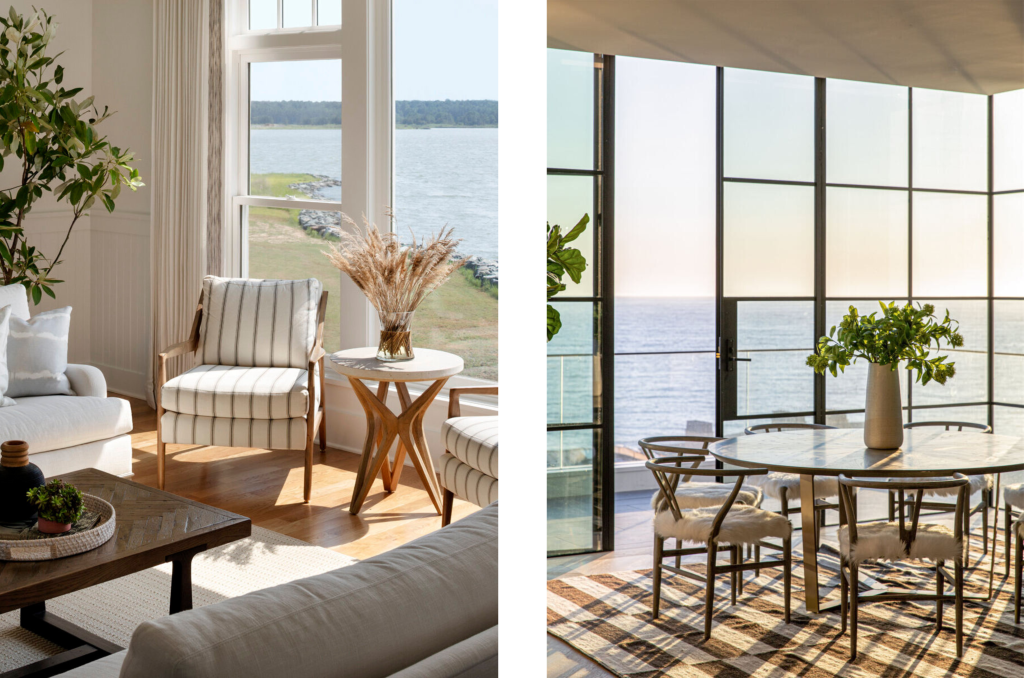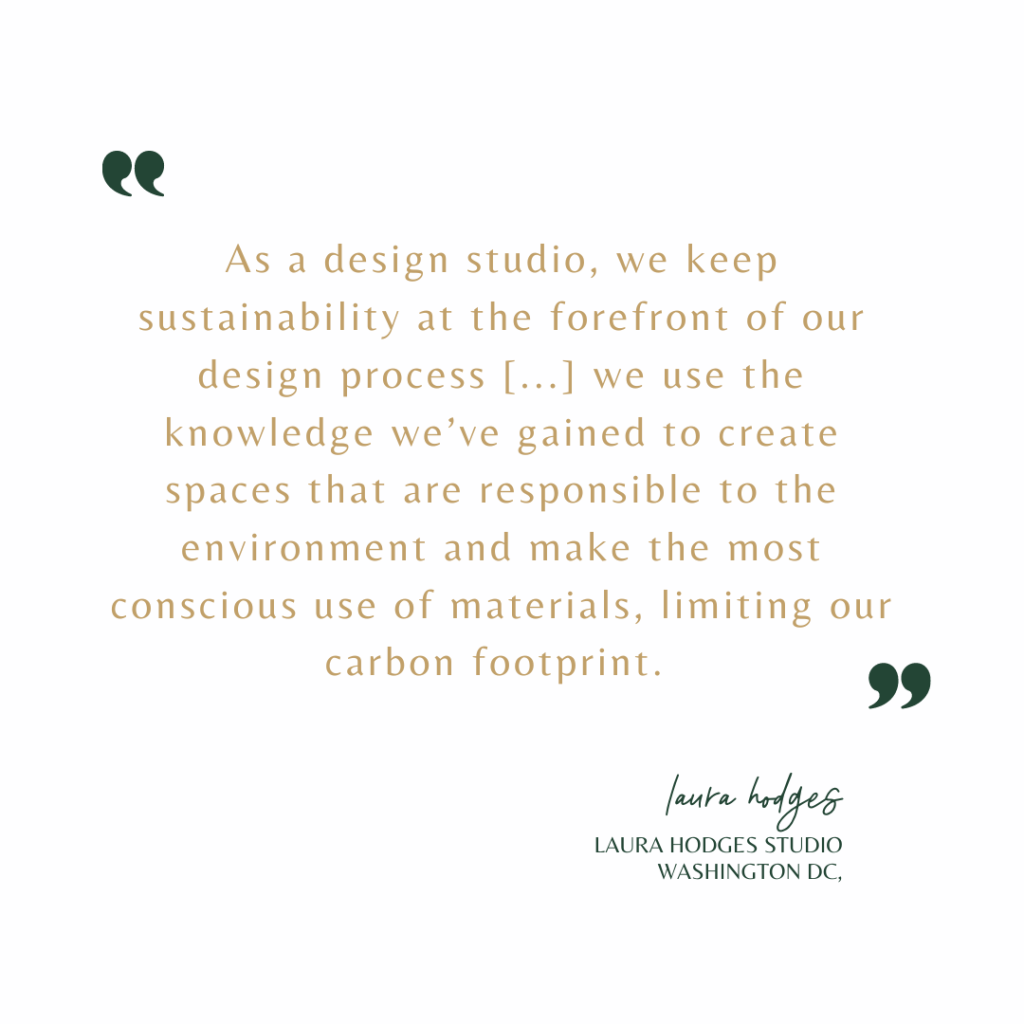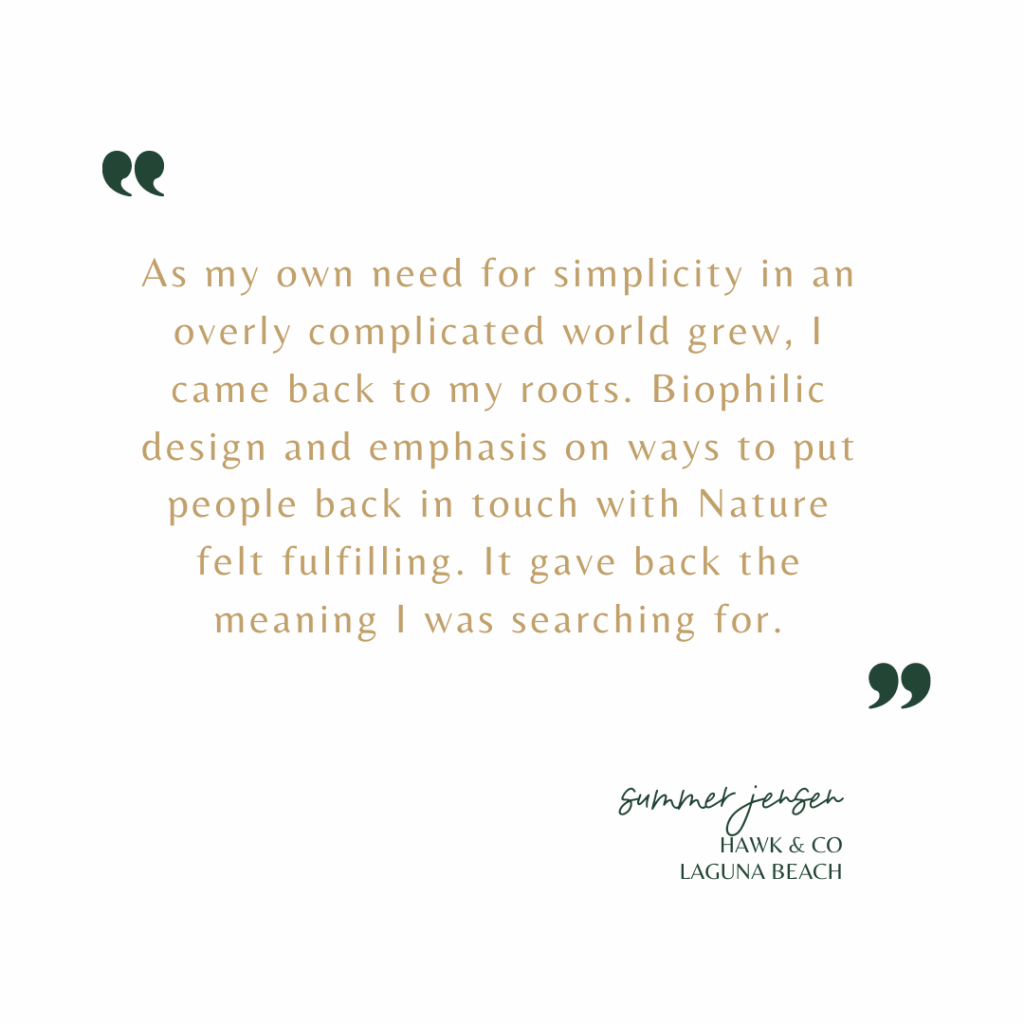Sustainable interior design: an eco-friendly approach to create a beautiful, functional and safe home for a homeowner AND their environment. A growing trend in our industry (no pun intended) we tapped in to two interior designers who are on the forefront of this conscious practice, to ask the burning question: how can it benefit your bottom line?
Sustainable Interior Design: How it Can Benefit Your Bottom Line


left: laura hodges studio; right: hawk & co
LAURA HODGES
A boutique design firm located in the Baltimore / Washington DC area, Laura Hodges Studio focuses on creating beautiful, tailored spaces while fully expressing every client’s individual style and taste. Principal Laura Hodges is known for an international aesthetic along with a love for unique and dynamic environments. Influenced by a Norwegian grandmother, British mother and Jamaican father, Laura developed an early appreciation for travel and diverse cultures, having traveled extensively to over thirty countries — from Greece and Morocco to Thailand and Peru. Laura Hodges Studio’s signature aesthetic is clean, tailored, and eclectic, incorporating unique vintage and antique finds, curated art and natural elements.
SUMMER JENSEN
The Hawk & Co moniker pays homage to principal Summer Jensen’s Hawaiian family roots. The ka‘io, Hawaii’s native hawk whose radiance inspired the ali’i, or chiefs, to adopt it as a royal symbol. The noble reference is a fitting one. It matches Jensen’s dedication to her design sensibilities: contrasting light and shadow, exquisitely meticulous attention to detail and a deference to the natural environment. She feels, “Mother nature is the greatest artist”. And with her bird’s eye view and overarching eye for intuition of a client’s understanding and trust, Jensen is in a design stratosphere all her own.


Laura, you have a LEED accreditation for practicing sustainable design and are LEED AP and a GREEN AP. Can you please share with our readers what these accreditations mean for your practice and what requirements each of your projects must meet?
Being a LEED AP requires a rigorous study of sustainable building practices and an understanding of the process by which a structure becomes LEED certified by the USGBC. The GREEN AP program is more focused on interior furnishings and the accreditation requires knowledge of the effects of the design industry on climate change, how to create furnishings more sustainably and our impact as designers and makers. As a design studio, we keep sustainability at the forefront of our design process. Unless the building owner is seeking LEED certification, we’re not required to fulfill any specific criteria for most of our projects, but we do use the knowledge we’ve gained to create spaces that are responsible to the environment and make the most conscious use of materials, limiting our carbon footprint.
You quote so elegantly on your website, “Good design is also sustainable design, and we make a commitment to our clients, our community and our environment to be eco-conscious in our design practices.” How do you effortlessly weave in sustainability at the forefront of each step in your design process?
Whether it’s repurposing existing furniture and materials, avoiding VOCs and off-gassing, integrating insulating materials to efficiently heat and cool a space, or sourcing furnishings more responsibly, we do our best to consider how our design will impact our environment. We prefer to source from sustainable manufacturers, so we prioritize those vendors that we know are working in a responsible way to source renewable materials, efficiently produce with little waste, reduce their carbon footprint and maximize their water usage. It’s also important that our vendors create a safe working environment and pay their employees a fair wage so we can let our clients know that their project supports communities and doesn’t come at someone else’s expense. Lastly, we love to source from brands that produce in America with traceable material sources and transparent fabrication methods, so we can reduce environmental transportation costs and support our local communities.
You are incredibly philanthropic and involved in organizations such as The Children’s Home, the Catonsville Women’s Giving Circle and Second Chance. Can you share a few of your most impactful projects with these organizations and what you are most proud of?
We recently worked with The Children’s Home, a residential home for displaced youth, to create a new café for their residents, forming partnerships with local businesses and tradespeople to bring the project to life. Nicknamed the Treehouse Café, this space was designed to uplift and support the young residents of the Home and give them a space to connect with each other. Additionally, when we recently renovated a law firm, since we were updating all the furnishings, we coordinated with our client to donate all of their office furniture to The Children’s Home for their boardroom and back offices.
How can sustainable interior design increase a designer’s bottom line? Can you provide an example or two, please?
Sustainable design can increase your bottom line if you integrate the practice into everything you do in an authentic way and offer the added value to your clients. Our clients love the stories we can tell them about where their furniture and decor was made (and often by whom) and that level of connectedness is invaluable, whether it’s to their local community or a faraway artisan collective.


Biophilic design has long been a part of your practice, even before you knew the name for it. How did you get started in sustainable design, and why is it important to you?
Sustainable design wasn’t always a part of my practice, but as I saw more and more newly built homes demolished due to poor construction or a change in “style”, it became a morality issue for me. To take without giving back pained me to see it happening all over our industry. As my own need for simplicity in an overly complicated world grew, I came back to my roots. Biophilic design and emphasis on ways to put people back in touch with Nature felt fulfilling. It gave back the meaning I was searching for.
Part of my mission is to demystify sustainable design for the masses. As design professionals, it’s surprising to me how little people talk about the health and wellness of their home and not just the wallpaper or art.
What are your favorite sustainable resources to incorporate into your interior design practice? There is a lot to consider when designing a home while keeping sustainability in mind from the site, to the lumber used to incorporating natural light…when you dive into a project, how do you keep sustainability as the highest priority?
To sustain is the ability to maintain a certain level. Or in layperson’s terms; equal in, equal out. Here is how I see how sustaining applies to home building:
- Passive architecture – to orient the house to use natural daylight and cross breeze for most of the day. At this stage, organize the home to be efficient such as clustering services near each other like bathrooms back-to-back, kitchens adjacent to laundry rooms. Wasted space also counts as not sustainable…encouraging smaller, more efficient builds. The best way to be sustainable is to reduce consumption.
- Net-zero / energy production – most people are savvy when it comes to solar energy, but some others like geothermal heat pumps may also be on your radar.
- Mechanical systems – heating and cooling of the home is the single largest use of energy. Efficient cross breezes, heat sinks, ceiling fans and hydronic heating can all lessen that load.
- Water use – to capture rainwater for daily use as well as to reuse the water from our showers and sinks for landscaping…or get crazy and convert the methane from the black water waste and be able to power appliances.
- Finishes and furniture – these should be 0 VOC with only water-soluble adhesives. All timber should be sustainable, FSC certified and hopefully fast growth. But more importantly, start asking manufacturers questions to let them know that these are important issues to you. Let’s get the industry to not accept anything less than biodegradable packing materials and palette wrap.
- Think about the cuts of wood you use; plain sliced wood has a yield of up to 90% whereas rift white oak’s yield is between 50-60%. What sizes are you specifying and how much waste does your design create?
- There are a ton of products that claim to be green. Do your research and understand what your objective is. I choose biodegradability over longevity, which means I reject Petra-chemical products whenever I can.
- Furniture foams are one of the worst culprits of toxic chemicals. Ask for natural latex and wool batting instead of poly-fill. I would be suspicious of anything that is off-gassed.
- I also give preference to local vendors and/or vendors who support worthy causes or are from underprivileged areas.
- Food equity – How can you add equity to this home like integration of food production? From a few tomatoes on a vine to more elaborate food production. Who doesn’t want to know exactly what they are eating these days?
How can sustainable interior design increase a designer’s bottom line? Can you provide an example or two please?
“You don’t need to choose between being purpose driven and being profit-driven, that is the big misconception” – Julie Mathers, CEO of Flora & Fauna.
I start by asking questions to the clients and produce a base strategy of the home. My first question is always, “would you rather have a home that is toxic or non-toxic?” 100% of respondents say the latter. After you set the client’s green priorities, start speaking with your design team and engineers to express your goals of wanting to build a sustainable home.
There is a plethora of information out there and many people waiting for the opportunity to work on projects with new technology. This technology is often more efficient and cost saving, which in turn impacts the bottom line. I’m pleasantly surprised by how many people have built a net-zero home. Be ahead of the pack and find small ways at first to think about your impact. The more conscious you become, the more you will dive into other parts of sustainability.

